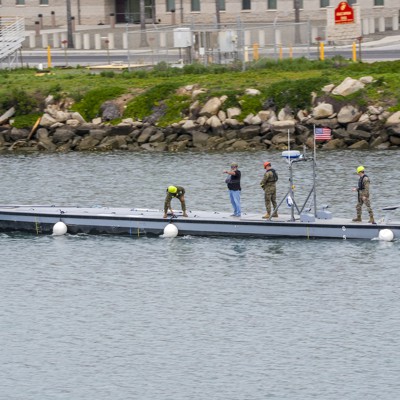Leidos is a longtime government contractor known for IT—as well as missiles and airport body scanners. But CEO Thomas Bell said the company is poised for a breakaway in maritime autonomy.
“We’re not seen as at the vanguard of this, but we’re about to surprise people,” Bell told reporters at the company’s supplier and technology symposium. “It is fair to say, back in the day, we were a federal IT contractor, and that was the dominant business. That’s still a big part of my business. And I think what we’re seeing right now is the convergence, actively, of hardware and software.”
Maritime autonomy has become buzzworthy, with the budgets to back it up. And the field is getting crowded, as several companies vie for a chance to make the Navy’s goal of having a hybrid fleet—and supercharge operations—real. Some are backed by private capital, such as Saronic, Saildrone, HavocAI, and Anduril, and others who have been in the game a little longer, like Saab, Textron Systems, and L3Harris. Traditional shipbuilders HII and General Dynamics are also key players.
But Bell said what sets Leidos apart is its software and strategic acquisitions. For example, while other hardware-focused companies are teaming up, like L3Harris and Palantir, Leidos is keeping everything in-house, since it acquired the research and security firm Dynetics in 2020.
“Years ago, we bought Dynetics in Huntsville, Alabama. We have a robust defense business. We bought [Security Enterprise Solutions]—so that’s our whole airport [scanner] and non-intrusive inspection regime that gives us these products and capabilities,” Bell said. “[Those] are placards, if you will, on a battlefield or in a customer’s hands. And that changes the scope of our value add.”
The company has been amassing maritime drone expertise for nearly a decade through acquisitions like ship designer Gibbs & Cox in 2021. They’ve also inked several shipyard partnerships in a bid to meet the Navy’s call for 78 uncrewed medium and large surface vessels and at least 56 uncrewed undersea vehicles. The company also recently partnered with Nauticus Robotics to work on undersea drone tech that can handle complex missions.
“We’re not world renowned as an autonomous naval vessel builder. That’s because we don’t build ships. But everything around it, and everything that enables those commercial shipyards to become government shipyards, we have, and we’re very excited about it,” Bell said.
The Marine Corps is already testing Leidos’ autonomous undersea vehicles. Earlier this year, the company unveiled a small, low-cost, attritable UUV called Sea Dart. And the Navy in October awarded Leidos a five-year, $248 million contract to design and engineer sea drone tech for maritime intelligence, surveillance and reconnaissance.
Additionally, the company’s LAVA, Leidos Autonomous Vehicle Architecture, powered USVs sailing from San Diego to Australia last year.
“I’m really happy to have all these points in Leidos, because they are all connected by software, autonomy, cybersecurity, and AI. Those are the substrates that connect all that hardware to all that software,” Bell said.
Read the full article here

